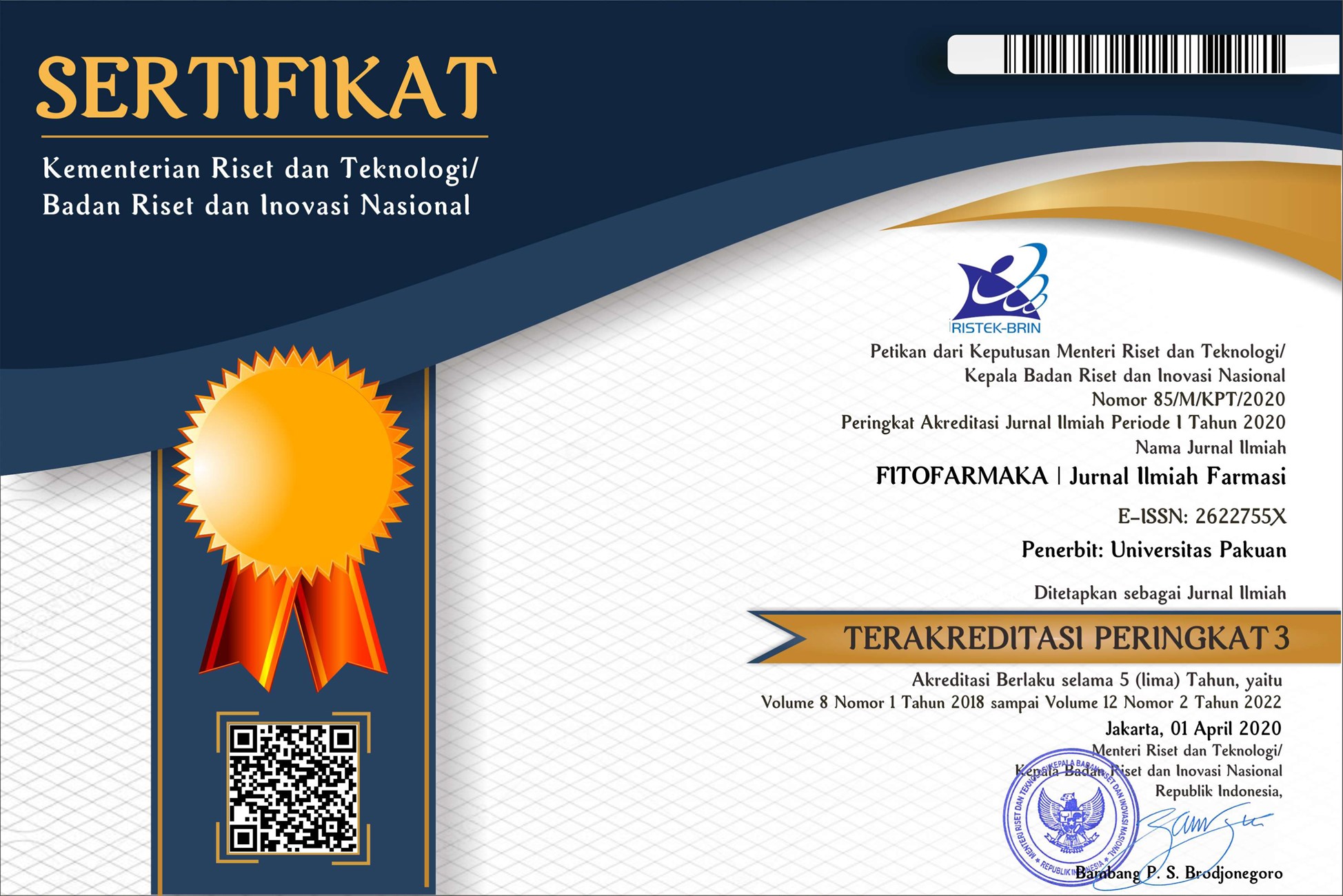RED GINGER (Zingiber officinale var. rubrum): ITS CHEMICAL CONSTITUENTS, PHARMACOLOGICAL ACTIVITIES AND SAFETY
Abstract
Ginger (Zingiber officinale) which belongs to the Zingiberaceae family, was first cultivated in Asia (Indonesia and Malaysia). This plant is one of the most commonly used herbal supplements taken by many patients to treat various conditions. Z.officinale has three varieties based on its size, colors of rhizome and chemical constituents i.e. .Z. officinale var. officinale (big white ginger or giant ginger, badak or gajah), Z. officinale var. amarum (small white ginger, emprit), and Z. officinale var. rubrum (small red ginger, merah or beureum). These three varieties may partly be deferred from their essential oil contents and are used for different purposes. The essential oils contained in Z. officinale var. rubrum are higher than the other types of ginger, which makes stronger in its pungency smell and taste. There are many studies that confirm beneficial effects of red ginger against the symptoms of diseases, i.e. anti-inflammation, antioxidant, antiemetic, antibacterial and antidiabetics. Z.officinale var. rubrum is considered to be a safe herbal medicine with only few and insignificant adverse/side effects. Although the medicinal properties of red ginger have been known, further trials in humans are required to determine the efficacy of red ginger (or one or more of its constituents) and to establish what, if any, adverse effects are observed.
Keywords
References
Ali, J. B., G. Blunden, G., M.O. Tanira, A. Nemmar. 2008. Some Phytochemical, Pharmacological and Toxicological Properties of Ginger (Zingiber officinale Roscoe): A Review of Recent Research. Food and Chemical Toxicology. 46(2): 409-420.
Amin-al Z.M., M. Thomson, K.K. Al-Qattan, R. Peltonen-Shalaby, M. Ali. 2006. Antidiabetic and hypolipidaemic properties of ginger (Zingiber officinale) in streptozotocin-induced diabetic rats, British Journal of Nutrition. 96: 660-666.
Akhani S.P., S.L. Vishwakarma, R.K. Goyal. 2004. Anti-diabetic activity of Zingiber officinale in streptozotocin-induced type I diabetic rats. J Pharm Pharmacol. 56(1): 101-105.
Bhargava, S., D. K. Shipra, A. Batra, A. Sharma, B. Malhotra. 2012. Zingiber officinale: Chemical and phytochemical screening and evaluation of its activities. Journal of Chemical and Pharmaceutical Research. 4(1): 360-364.
Bhattarai, S., H.V. Tran, C.C. Duke. 2001. The Satbility of gingerol and shogaol in aqueous solution. Journal of Pharmacetical Sciences. 90:1658-1664
Chaiyakunapruk N., N. Kitikannakorn, S. Nathisuwan, K. Leeprakobboon, C. Leelasettagool. 2006. The efficacy of ginger for the prevention of postoperative nausea and vomiting: a meta-analysis. Obstet Gynecol 194(1): 95-99.
Ghasemzadeh, A., H. Jaafar, A. Rahmat. 2015. Optimization protocol for the extraction of 6-gingerol and 6-shogaol from Zingiber officinale var. Rubrum theilade and improving antioxidant and anticancer activity using response surface methodology. BMC Complementary and Alternative Medicine. 15(258): 1-10.
Habib, S.H.M., S. Makpol, I. Hamid, S. Das, W. Ngah, Y.A.M Yusof. 2008: Ginger extract (Zingiber officinale) has anti-cancer and anti-inflammatory effects on ethionine-induced hepatoma rats. Clinics. 63(6): 807-813.
Kemper, J.K. 1999. Ginger (Zingiber officinale). The Longwood Herbal and Task Force and The Center for Holistic Pediatric Education and Research. 1-18.
Kitagata, C. N., I. Ichinomiya, A. Aichi. 2011. Red ginger extract an all natural anti-arthritic and anti inflammatory agent for food and cosmetics applications. Oryza Oil and Fat Chemical. 1-31.
Kumar, G., I. Karthik, Rao, B. 2011. A Review on pharmacological and phytochemical properties of Zingiber officinale roscoe (Zingiberaceae). Journal of Pharmacy Research. 4: 2963-2966.
Marwat, K.S., M. Shoaib, A.E. Khan, F. Rehman, H. Ullah, H. 2015: Phytochemistry and bioactivities of Quranic plant, zanjabil-ginger (Zingiber officinale Roscoe): A review. American-Eurasian J. Agric & Environ. Sci. 15(5): 707-713.
Mesomo, C.M., A.P. Scheer, E. Perez, E., P.M. Ndiaye, L.M. Corazza. 2012. Ginger (Zingiber officinale R.) extracts obtained using supercritical CO2 and compressed propane: kinetics and antioxidant activity evaluation. The Journal of Supercritical Fluids. Brazil. 71: 102-109.
Norajit, K., N. Laohakunjit, O. Kerdchoenchuen. 2007. Antibacterial effect of five Zingiberaceae essential oils. Molecules. 12:2047-2060.
Prasad, S., dan K.A.Tyagi. 2015. Ginger and its constituents: role in prevention and treatment of gastrointestinal cancer. Gastroenterology Research and Practice. 1 12.
Riyazi A., A. Hensel, K. Bauer, N. Geissler, S. Schaaf, E. Verspohl. 2007. The effects of the volatile oil from ginger rhizomes (Zingiber officinale), its fractions and isolated compounds on the 5-HT3 receptor complex and the seratoninergic system of the rat ileum. Planta Medica. 73:355-362.
Ross. I. 1999. Medical Plants of the World Chemical Constituet Traditional and Modern Medical Uses. Human Press. New Jersey.
Setyawan, D.A., W. Wiryanto., S. Suranto dan N. Bermawie. 2014. Short communication: Variation in isozymic pattern of germplasm from three ginger (Zingiber officinale) varieties. Nusantara Bioscience. 6(1): 86-93.
Shan, S.J., J. Tanaka, A. Seki, J.W. Seo, N. Kasajima, S. Tamura, Y. Ke, N. Murakami N. 2010. Anti-inflamatory properties of red ginger (Zingiber officinale var. Rubra) extract and suppression of nitric oxide production by its constituents. Journal of Medical Food. 13(1): 156-162.
Siddaraju, M. dan S. Dharmesh. 2007. Inhibition of gastric H+, K+-ATPase and helicobacter pylori by phenolic antioxidants of Zingiber officinale. Mol Nutr Food. 51:324-332.
Singletary, K. (2010) : Ginger, An overview of health benefits. Food Science. 45(4). 171-183.
Supriadi S., Y. Yusron, D. Wahyuno. 2011. Ginger (Zingiber officinale Rosc.). Research Institute for Medicinal and Aromatic Plants. Ministry of Agriculture. 1 19.
White, B. 2007. Ginger: an overview. Complementary and Alternative Medicine. American Academy of Family Physicians. University of Southern California, Los Angeles, California. 1599-1691.
Wohlmuth, H., D.N. Leach, M.K. Smith, S.P. Myers. 2005. Gingerol content of diploid and tetraploid clones of ginger (Zingiber officinale Roscoe). J. Agric. Food Chem. 53(14): 57725778.
DOI: 10.33751/jf.v8i1.1168
 Abstract views : 7495
Abstract views : 7495
Refbacks
- There are currently no refbacks.













